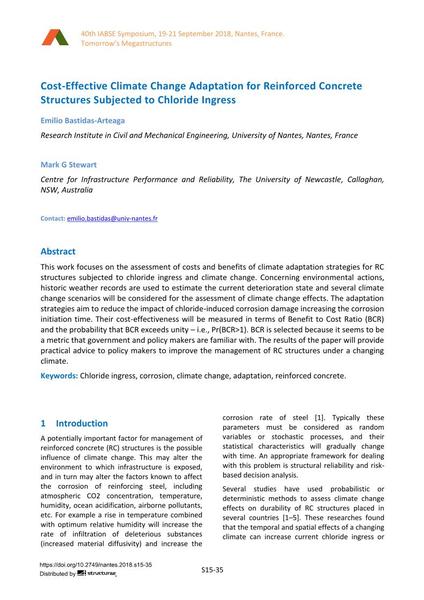Cost-Effective Climate Change Adaptation for Reinforced Concrete Structures Subjected to Chloride Ingress

|
|
|||||||||||
Détails bibliographiques
| Auteur(s): |
Emilio Bastidas-Arteaga
(Research Institute in Civil and Mechanical Engineering, University of Nantes, Nantes, France)
Mark G. Stewart (Centre for Infrastructure Performance and Reliability, The University of Newcastle, Callaghan, NSW, Australia) |
||||
|---|---|---|---|---|---|
| Médium: | papier de conférence | ||||
| Langue(s): | anglais | ||||
| Conférence: | IABSE Symposium: Tomorrow’s Megastructures, Nantes, France, 19-21 September 2018 | ||||
| Publié dans: | IABSE Symposium Nantes 2018 | ||||
|
|||||
| Page(s): | S15-35 | ||||
| Nombre total de pages (du PDF): | 8 | ||||
| DOI: | 10.2749/nantes.2018.s15-35 | ||||
| Abstrait: |
This work focuses on the assessment of costs and benefits of climate adaptation strategies for RC structures subjected to chloride ingress and climate change. Concerning environmental actions, historic weather records are used to estimate the current deterioration state and several climate change scenarios will be considered for the assessment of climate change effects. The adaptation strategies aim to reduce the impact of chloride-induced corrosion damage increasing the corrosion initiation time. Their cost-effectiveness will be measured in terms of Benefit to Cost Ratio (BCR) and the probability that BCR exceeds unity – i.e., Pr(BCR>1). BCR is selected because it seems to be a metric that government and policy makers are familiar with. The results of the paper will provide practical advice to policy makers to improve the management of RC structures under a changing climate. |
||||
